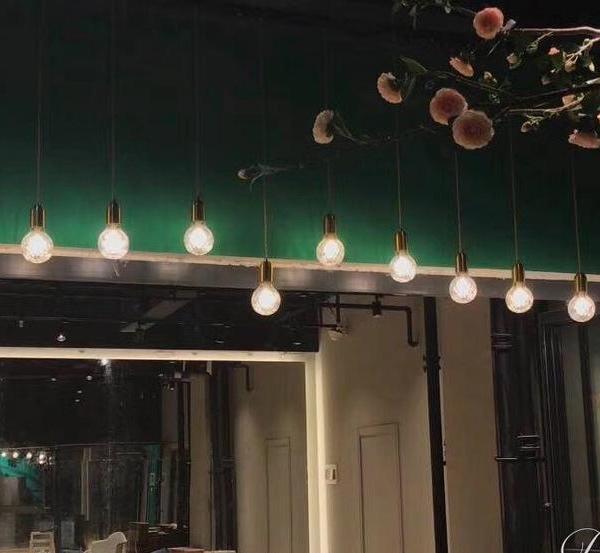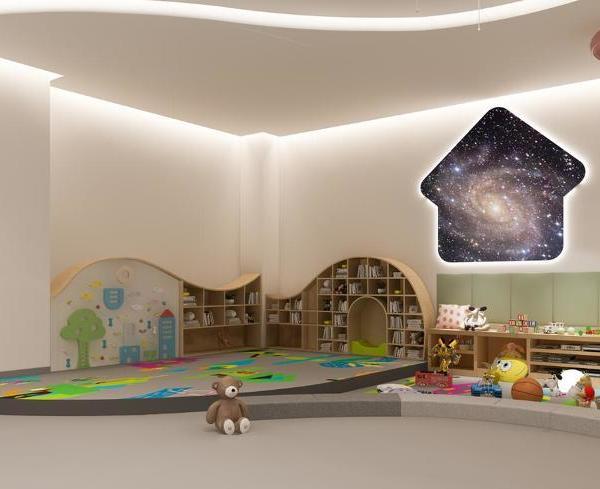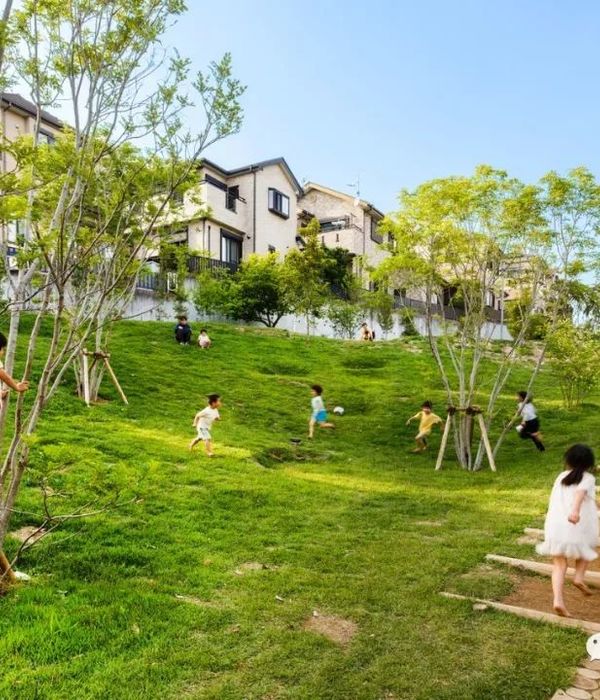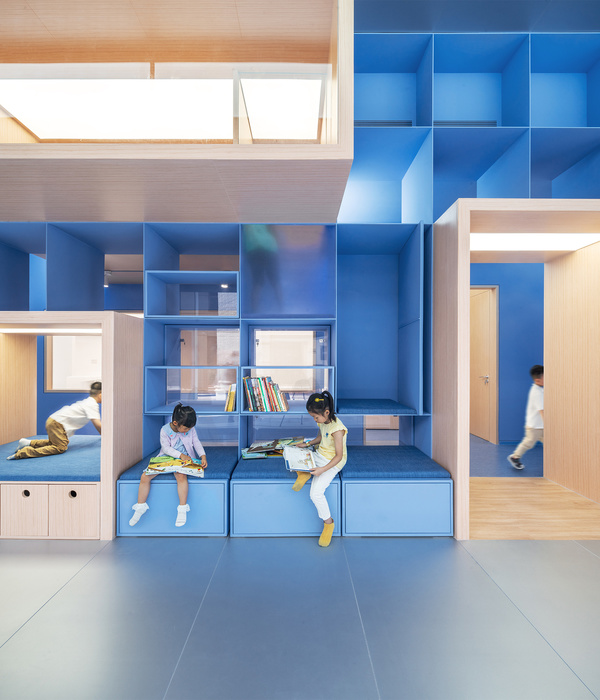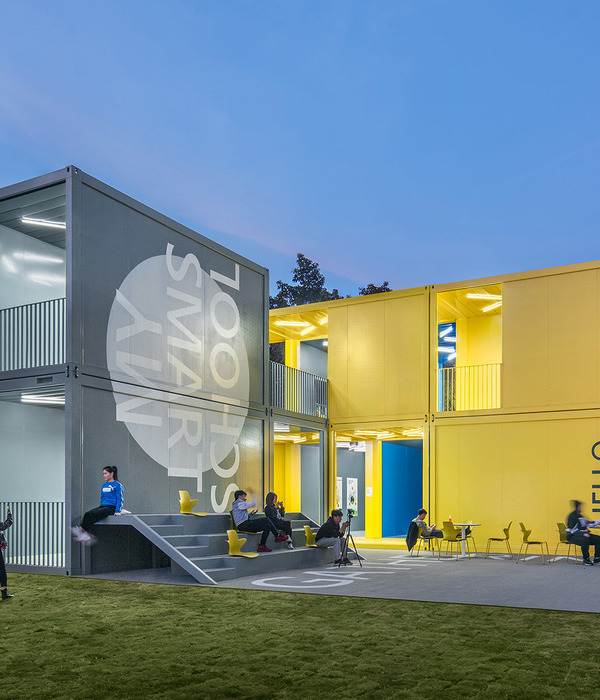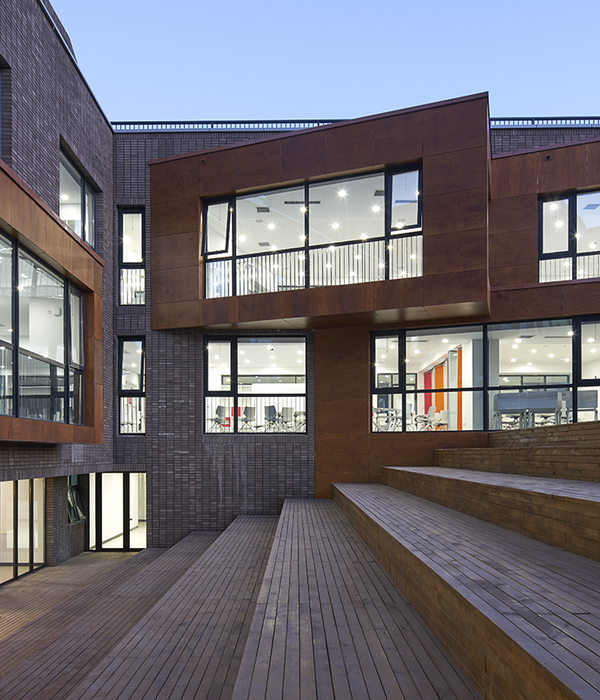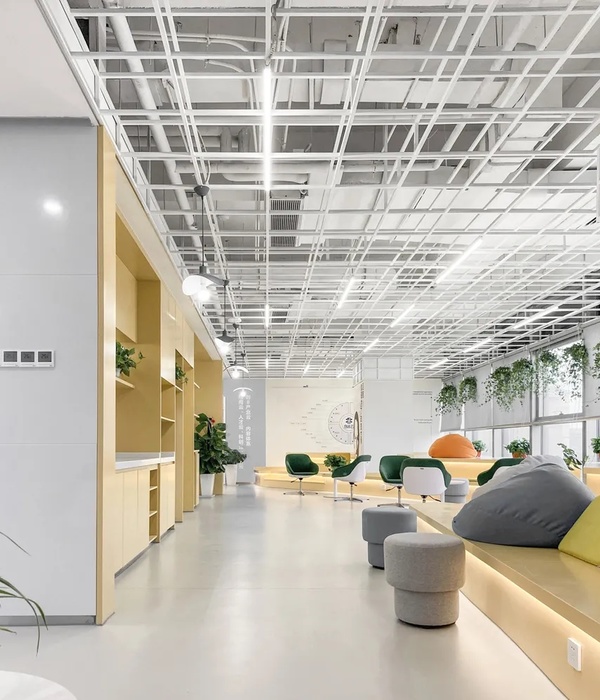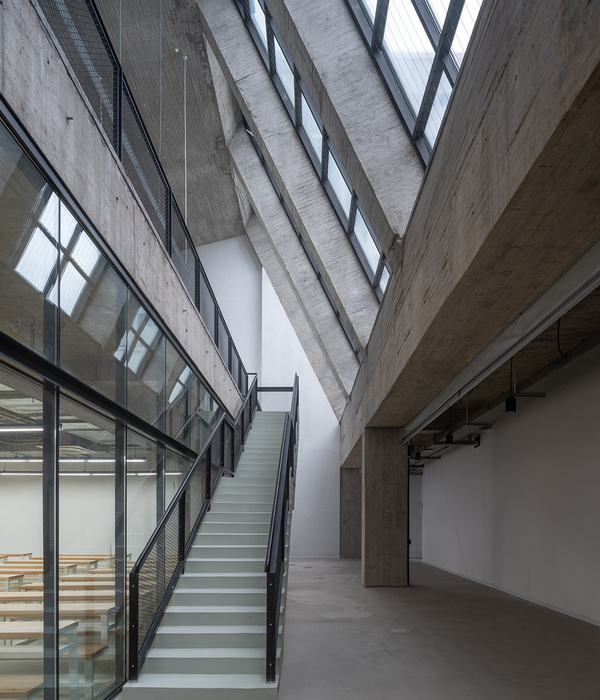建筑师希望这样的设计能吸引当地居民在上下学高峰之外使用休憩,以促进这所私立学校与周边邻里的关系,将这个公共空间作为学校馈赠给周边社区的礼物。
▼朱红色的折面结构,The scarlet folding surfaces © 张子彦
校门旁的家长等候区采用风雨廊的设计,延续了在空间中不断翻折的折面语言。平面上的折线从入口处沿着原先的校园边界延伸,可以最大程度上容纳等候的家长在此处遮阳避雨。这些折线在校园和市政道路之间围合出几个大小不一的口袋空间,创造出聚集的氛围,为未来不同的活动提供了可能性。折线与场地边线之间的缝隙成为了花池,种植了当地常见的观赏植物。马路对面绿化带的植物也被借景作为设计中的一部分,使得穿梭在廊道中的体验近乎于传统园林的感觉。
The parent waiting area adjacent to the school gate has been designed as a garden promenade, carrying forward the folding language within the space. The folding lines on the plan extend from the main entrance and stretch along the original campus boundary, providing additional areas for parents seeking shelter from the sun and rain. These folds create enclosed pockets of various sizes between the campus and the municipal road, fostering a sense of gathering and offering potential for diverse future activities. The spaces between the folds and the site’s edge are transformed into planting ponds adorned with local plants. Additionally, plants from the green belt across the road have been incorporated into the design, lending an almost traditional garden-like experience to those walking through the corridor.
▼近乎于传统园林的感觉,Almost traditional garden-like experiencee © 张子彦
The architects hope that such a design will attract local residents to utilize the space for recreation outside of the peak school hours, and thus foster a relationship between this enclosed private school and the surrounding neighborhood, presenting this public space as a gift from the school to the surrounding community.
▼家长等候区地面铺装,floor paving in parent waiting area © 蹊径设计
▼总立面图,overall elevation © 蹊径设计
▼入口处平面图和立面图,entrance plaza & gate plan and elevation © 蹊径设计
▼保安室立面图,guard room elevation © 蹊径设计
▼等候区剖面图,waiting area section © 蹊径设计
建筑师将中国传统建筑中大门的形象提炼为简洁有力的折面形式,具有现代雕塑感的同时保留了一些古典的韵味。墙面向内倾斜,展示了迎接的姿态,也给校园入口创造了视觉深度。新校门的单坡屋顶巧妙地定义了空间氛围,使日常进出学校的过程成为一种庄重的体验。
Located in Kunming, China, the project aims to redefine the entrance and boundaries of this campus. The school is a 12-year boarding school with approximately 5,000 students and teachers. The campus is located in a typical Chinese urban setting, surrounded by residential blocks mostly built in the early 2000s. However, as is typical for campuses, existing walls separate the school from the surrounding community, creating a small, inward-looking, self-sufficient community. Due to changes in the land use and road reconfiguration, the original main entrance will no longer be usable. Therefore, the school called for a new main entrance at the back entrance of the campus, and asked for minimizing the impact to the existing campus facilities. The school hopes that the new entrance to bring an architectural identity that was in line with the school’s philosophy: as a private school affiliated with one of the oldest and most prestigious university in China, the school wanted to incorporate symbols of traditional Chinese architecture into the design, yet, as an experimental school, they also seeks to establish a distinctive and innovative character.
▼校园入口处概览,Overall view of the enrtrance © 张子彦
▼入口近景,Close view of the entrance © 张子彦
校园原后门在一条相对狭窄的支路上上,龙江公园隔路相望,周围环境优美,绿意盎然。建筑师也将回应场地限制及建筑与自然之间的关系作为这个项目的重点。为了在相对狭窄的支路上容纳上下学时密集的人流和车流,建筑师将原有场地的边线向内缩进10米,创造了一个三角形的校门入口广场。新建校门位于入口广场的末端,收束整个空间,并与马路对面的红色步行桥形成了一条延续既有轴线的视觉连接。由大门在场地上的几何形状延伸出的折线成为了校园内外的空间控制线,在不同位置继续进行折叠变化,形成了三个主要空间:校门广场、入门广场和家长等候区。
▼项目模型,model © 蹊径设计
The original back entrance to the campus is on a relatively narrow bypass with Long Jiang Park across the road, surrounded by beautiful greenery. The architects draw on the constraints of the site and the relationship between nature and architecture, and consider these as the starting point for this project. In order to accommodate the heavy pedestrian and vehicular traffic on the relatively narrow street, the architects have pushed the edge of the original border inward by 10 meters which created a triangular plaza. The new gate is located at the tip of the entrance plaza, anchoring the space, and creating a visual connection with the red pedestrian bridge across the road that continues the existing axis. The extension of the projected geometry of the new entrance on the ground has become the spatial control line both inside and outside the campus. The zigzag line continues to fold and transform at different locations, forming three main spaces: the school gate plaza, the entrance plaza, and the parents’ waiting area.
▼正门,The gate © 张子彦
项目位于中国昆明市,旨在改造这座校园的入口和边界。该学校是一所十二年一贯制学校,拥有约5千名师生。校园位于一个典型的中国城市环境中,周围大多是建于2000年初的社区。然而,如同典型的校园,现有的围墙将学校与周边社区分隔开来,形成了一个内向、自给自足的小社区。由于城市用地性质的变化和道路的重新规划,原先的主入口将无法继续使用。因此,该项目要求在原校园后门处新建一个学校的主入口,同时尽量不占用校园现有设施。校方希望新建项目能够为学校带来一个与办学理念相契合的建筑形象:作为隶属于知名大学的私立学校,校方希望在建筑设计中延续中国传统建筑的元素,然而,作为一所实验学校,他们也希望在设计上展现出与众不同的创新特色。
The architects have distilled and translated the essence of the traditional Chinese Gate into a simple but powerful folding structure. The gently inclined side wall extends a warm invitation, imbuing the campus entrance with a sense of visual depth. The sloping roof of the new gate subtly shapes the spatial atmosphere, heightening the daily journey of entering the school with an elevated experience.
▼正门细部,Details of the gate © 张子彦
▼保安室,Guard room © 张子彦
项目的折面结构采用朱红色耐候钢完成。材料独特的表面纹理为简洁的造型增添了丰富的视觉层次,斑驳的质感带来了岁月的痕迹,使校园的更新与周围环境更加协调。朱红色不仅唤起人们对中国传统建筑的联想,同时在绿植环境中成为视觉焦点。这种强烈的色彩对比和明暗阴影也与呼应了昆明的阳光与气候环境。此外,项目还运用了传统园林建筑常见的铺地材料,如瓦片、青石板和碎石,以唤起人们集体记忆中那种熟悉的感觉。
The folding surfaces of the project are made out of vermillion weathering steel. The material’s unique surface texture adds richness and depth to the minimal form, while the rusty stain evokes a sense of time and harmonizes the campus renewal with its surrounding built environment. The red not only evokes associations with traditional Chinese architecture but also serves as a visual focal point within the lush greenery. The strong color contrast and interplay of light and shadow also resonate with the abundant sunlight and the tropical climate of Kunming. Besides, the project incorporates traditional paving materials and methods commonly found in classical Chinese gardens, such as using traditional roof tiles (as ground paving), bluestone slabs, and irregularly paved broken stones. All of the materials are used to evoke a sense of familiarity and collective memory from locals.
▼家长等待区,Parents waiting area © 张子彦
▼孩子们在等待区玩耍,Children playing at the waiting area © 张子彦
{{item.text_origin}}

